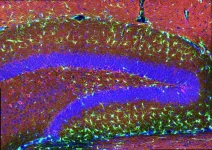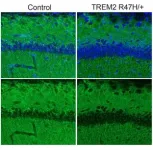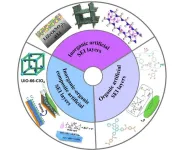(Press-News.org) A rare but potent genetic mutation that alters a protein in the brain’s immune cells, known as microglia, can give people as much as a three-fold greater risk of developing Alzheimer’s disease. A new study by researchers in The Picower Institute for Learning and Memory at MIT details how the mutation undermines microglia function, explaining how it seems to generate that higher risk.
“This TREM2 R47H/+ mutation is a pretty important risk factor for Alzheimer’s disease,” said study lead author Jay Penney, a former postdoc in the MIT lab of Picower Professor Li-Huei Tsai. Penney is now an incoming assistant professor at the University of Prince Edward Island. “This study adds clear evidence that microglia dysfunction contributes to Alzheimer’s disease risk.”
In the study in the journal GLIA, Tsai and Penney’s team shows that human microglia with the R47H/+ mutation in the TREM2 protein exhibit several deficits related to Alzheimer’s pathology. Mutant microglia are prone to inflammation yet are worse at responding to neuron injury and less able to clear harmful debris including the Alzheimer’s hallmark protein amyloid beta. And when the scientists transferred TREM2 mutant human microglia into the brains of mice, the mice suffered a significant decline in the number of synapses, or connections between their neurons, which can impair the circuits that enable brain functions such as memory.
The study is not the first to ask how the TREM2 R47H/+ mutation contributes to Alzheimer’s, but it may advance scientists’ emerging understanding, Penney said. Early studies suggested that the mutation simply robbed the protein of its function, but the new evidence paints a deeper and more nuanced picture. While the microglia do exhibit reduced debris clearance and injury response, they become overactive in other ways, such as their overzealous inflammation and synapse pruning.
“There is a partial loss of function but also a gain of function for certain things,” Penney said.
Misbehaving microglia
Rather than rely on mouse models of TREM2 R47H/+ mutation, Penney, Tsai and their co-authors focused their work on human microglia cell cultures. To do this they used a stem cell line derived from skin cells donated by a healthy 75-year-old woman. In some of the stem cells they then used CRISPR gene editing to insert the R47H/+ mutation and then cultured both edited and unedited stem cells to become microglia. This strategy gave them a supply of mutated microglia and healthy microglia, to act as experimental controls, that were otherwise genetically identical.
The team then looked to see how harboring the mutation affected each cell line’s expression of its genes. The scientists measured more than 1,000 differences but an especially noticeable finding was that microglia with the mutation increased their expression of genes associated with inflammation and immune responses. Then, when they exposed microglia in culture to chemicals that simulate infection, the mutant microglia demonstrated a significantly more pronounced response than normal microglia, suggesting that the mutation makes microglia much more inflammation-prone.
In further experiments with the cells, the team exposed them to three kinds of the debris microglia typically clear away in the brain: myelin, synaptic proteins and amyloid beta. The mutant microglia cleared less than the healthy ones.
Another job of microglia is to respond when cells, such as neurons, are injured. Penney and Tsai’s team co-cultured microglia and neurons and then zapped the neurons with a laser. For the next 90 minutes after the injury the team tracked the movement of surrounding microglia. Compared to normal microglia, those with the mutation proved less likely to head toward the injured cell.
Finally, to test how the mutant microglia act in a living brain, the scientists transplanted mutant or healthy control microglia into mice in a memory-focused region of the brain called the hippocampus. The scientists then stained that region to highlight various proteins of interest. Having mutant or normal human microglia didn’t matter for some measures, but proteins associated with synapses were greatly reduced in mice where the mutated microglia were implanted.
By combining evidence from the gene expression measurements and the evidence from microglia function experiments, the researchers were able to formulate new ideas about what drives at least some of the microglial misbehavior. For instance, Penney and Tsai’s team noticed a decline in the expression of a “purinergic” receptor protein involving sensing neuronal injury perhaps explaining why mutant microglia struggled with that task. They also noted that mice with the mutation overexpressed “complement” proteins used to tag synapses for removal. That might explain why mutant microglia were overzealous about clearing away synapses in the mice, Penney said, though increased inflammation might also cause that by harming neurons overall.
As the molecular mechanisms underlying microglial dysfunction become clearer, Penney said, drug developers will gain critical insights into ways to target the higher disease risk associated with the TREM2 R47H/+ mutation.
“Our findings highlight multiple effects of the TREM2 R47H/+ mutation likely to underlie its association with Alzheimer’s disease risk and suggest new nodes that could be exploited for therapeutic intervention,” the authors conclude.
In addition to Penney and Tsai, the paper’s other authors are William Ralvenius, Anjanet Loon, Oyku Cerit, Vishnu Dileep, Blerta Milo, Ping-Chieh Pao, and Hannah Woolf.
The Robert A. and Renee Belfer Family Foundation, The Cure Alzheimer’s Fund, the National Institutes of Health, The JPB Foundation, The Picower Institute for Learning and Memory and the Human Frontier Science Program provided funding for the study.
END
How a mutation in microglia elevates Alzheimer’s risk
A new MIT study finds that microglia with mutant TREM2 protein reduce brain circuit connections, promote inflammation and contribute to Alzheimer’s pathology in other ways
2023-11-16
ELSE PRESS RELEASES FROM THIS DATE:
International team uses Insilico Medicine’s AI platform to find dual targets for aging and cancer
2023-11-16
An international research team is the first to use artificial intelligence (AI) analysis to identify dual-purpose target candidates for the treatment of cancer and aging, the most promising of which was experimentally validated. The findings were published in the journal Aging Cell.
Researchers from the University of Oslo, University of Chicago Pritzker School of Medicine, and clinical stage AI-driven drug discovery company Insilico Medicine used Insilico’s AI target discovery engine, PandaOmics, to analyze transcriptomic data derived from ...
New therapeutic strategy to reduce neuronal death in amyotrophic lateral sclerosis
2023-11-16
Amyotrophic lateral sclerosis (ALS) is a neurodegenerative disease that affects neurons in the brain and spinal cord causing loss of muscle control. A study by the University of Barcelona has designed a potential therapeutic strategy to tackle this pathology that has no treatment to date. It is a molecular trap that prevents one of the most common genetic ALS-causing peptide compounds, the Poly-GR dipeptide, from causing its toxic effects in the body. The results show that this strategy reduces the death of neurons in patients and in an animal model (vinegar flies) of the disease.
The first authors of this international research study published in the journal Science Advances are ...
Breakthrough in bladder cancer research
2023-11-16
After 40 years of treating metastatic bladder cancer with chemotherapy as a primary treatment, scientists now present a new approach using immunotherapy combinations. The results of not just one, but two studies have been presented at the European Society for Medical Oncology (ESMO) conference in Madrid. The outcomes of these studies are going to revolutionize the landscape of bladder cancer treatment.
Traditionally, cisplatin-based chemotherapy has been the standard treatment for bladder cancer patients who are able to tolerate this drug. However, responses have been limited, and durable outcomes rare. Over the past years, two phase-3 clinical trials studied the effects ...
Study: Temperature variability reduces nesting success
2023-11-16
Ithaca, N.Y.—Many songbirds are nesting earlier in spring because of warmer temperatures brought about by climate change. But the shift brings another danger that is especially deadly for nestlings: greater exposure to temperature variability in the form of cold snaps and heat waves. Such extremes result in more nest failures. These findings come from a Cornell Lab of Ornithology study just published in the journal Nature Communications.
"When we talk about temperature changes, the focus is mostly on averages," said co-lead author Conor Taff, a researcher in Cornell University's ...
Understanding survival factors in critically ill patients on extracorporeal membrane oxygenation
2023-11-16
Extracorporeal membrane oxygenation (ECMO) is a widely used advanced life support procedure that provides cardiac and respiratory support to critically ill patients. ECMO use has been increasing exponentially over the last decade as it has shown success in resuscitating patients in critical situations like the COVID-19 pandemic and is now a lifesaving treatment modality in intensive care units (ICUs). However, prolonged ECMO use may be associated with an increased risk of mortality. Identifying risk factors for in-hospital mortality and developing standardized nursing practice guidelines for ECMO management may improve the survival rates in patients.
In this vein, ...
Dr. Ralph and Marian Falk Medical Research Trust awards $1.35M to two Case Western Reserve University researchers
2023-11-16
CLEVELAND—A combined $1.35 million from the Dr. Ralph and Marian Falk Medical Research Trust was awarded to two researchers from the Case Western Reserve University School of Medicine to advance their work on finding more effective treatments—and better options—for two debilitating diseases.
The Falk Trust awarded Reshmi Parameswaran, an assistant professor in the Department of Medicine, Division of Hematology/Oncology, pathology and pediatrics at the School of Medicine, $1 million over three years for her work in cancer cell therapy.
Carlos Subauste, a professor of medicine and pathology at the School of Medicine, received a two-year, ...
High levels of maternal stress during pregnancy linked to children’s behavior problems
2023-11-16
WASHINGTON – Children whose mothers are highly stressed, anxious or depressed during pregnancy may be at higher risk for mental health and behavior issues during their childhood and teen years, according to research published by the American Psychological Association.
“Our research suggests that psychological distress during the pregnancy period has a small but persistent effect on children’s risk for aggressive, disinhibited and impulsive behaviors,” said study author Irene Tung, PhD, of California State University Dominguez Hills. “These findings add to the evidence that providing widely accessible mental health care and support ...
Catalyzing clinical change: The importance of representation in health care
2023-11-16
DALLAS, November 16, 2023 — Disparities in health care persist, with Hispanic and Black adults reporting less satisfaction with their interactions with physicians, leading to poorer quality of care and health outcomes.[1],[2],[3] While 19% of people in the U.S. identify as Hispanic, fewer than 7% of physicians do.[4] This lack of representation in the delivery of health care has been shown to exacerbate health disparities among underrepresented groups and is a significant barrier to the Hispanic Latino community achieving optimal health.[5]
In response to this challenge, the American Heart Association, a global force for ...
Lithium-ion batteries are no longer the gold standard in battery tech
2023-11-16
The use of lithium metal as the anode for batteries is one of the smarter options with better energy density than other materials. However, the interface between the electrode and electrolyte has quite a few issues that can be addressed for a safer and more functional outcome in the future.
The researchers are keen on replacing the graphite anode with lithium metal anode to construct a battery system with higher energy density. However, the Li metal anode is unstable and readily reacting with electrolyte to form a solid-electrolyte interphase (SEI). Unfortunately, the natural SEI is brittle and fragile, resulting in poor ...
Gene splicing reduces effectiveness of CD20-targeting monoclonal antibodies designed to treat variety of blood cancers and disorders
2023-11-16
Philadelphia, November 16, 2023 – Immunotherapies that target the CD20 antigen have revolutionized how patients with a variety of blood cancers and hematologic disorders have been treated. However, many patients develop resistance to these treatments due to a loss of the antigen that’s being targeted. Now, a new study from researchers at Children’s Hospital of Philadelphia (CHOP) and the Perelman School of Medicine at the University of Pennsylvania (Penn) has found that gene splicing occurring within these cells can cause significant changes in CD20 protein levels that render the therapies ineffective.
The findings, published today by ...
LAST 30 PRESS RELEASES:
Empress cicada wings help illuminate molecular structure
Using sound waves to detect helium
Time burden in patients with metastatic breast and ovarian cancer from clinic and home demands
Researchers discover bias in AI models that analyze pathology samples
Scientists ID potential way to prevent brain injuries from triggering Alzheimer's
MASTER 2nd Open Call: Execution period kick-off
Algae for health in food and pharma
Advanced microrobots driven by acoustic and magnetic fields for biomedical applications
Chicago health information leader recognized for raising CPR readiness and blood pressure awareness
The Intimate Animal, a new book from Kinsey Institute Executive Director Dr. Justin Garcia
When blue-collar workers lose union protection, they try self-employment
New video dataset to advance AI for health care
MEA-based graph deviation network for early autism syndrome signatures in human forebrain organoids
New modeling approach sheds light on rare gut disease
Study documents potentially hazardous flame retardants in firefighter gear
Can certain bacteria regulate aging of the immune system and its related alterations?
AI model helps diagnose often undetected heart disease from simple EKG
There are fewer online trolls than people think
Cell membrane fluctuations produce electricity
Jeonbuk National University study shows positive parenting can protect adolescents against self-harm
Surface-engineered ZnO nanocrystals to tackle perfluoroalkyl substance contamination
This new understanding of T cell receptors may improve cancer immunotherapies
A new fossil face sheds light on early migrations of ancient human ancestor
A new immunotherapy approach could work for many types of cancer
A new way to diagnose deadly lung infections and save lives
40 percent of MRI signals do not correspond to actual brain activity
How brain-inspired algorithms could drive down AI energy costs
Gum disease may be linked to plaque buildup in arteries, higher risk of major CVD events
Contrails are a major driver of aviation’s climate impact
Structure of dopamine-releasing neurons relates to the type of circuits they form for smell-processing
[Press-News.org] How a mutation in microglia elevates Alzheimer’s riskA new MIT study finds that microglia with mutant TREM2 protein reduce brain circuit connections, promote inflammation and contribute to Alzheimer’s pathology in other ways








